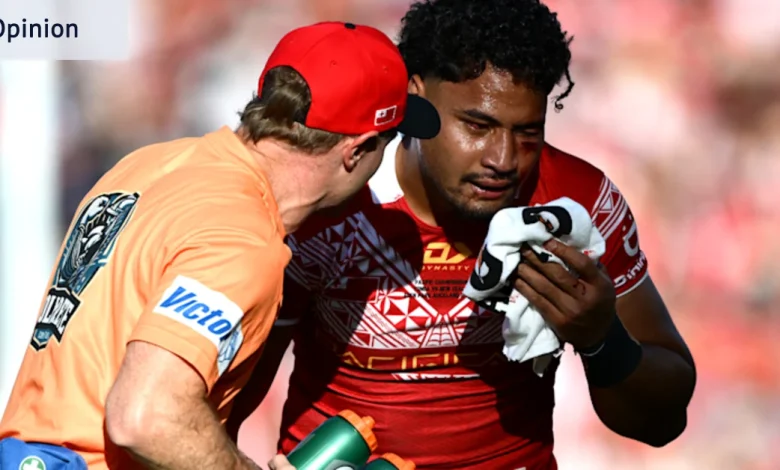Where sports have a duty of care, it must override the desire for personal autonomy

If neck and stem guards can be demonstrated to ameliorate the risks of serious injury or worse – from being struck by a cricket ball below the lower line of the helmet – and provided the guard doesn’t unduly inhibit a batter’s free range of movement, then there’s an inescapable conclusion.
That is, that governing bodies should require that any helmet a batter uses must conform to the requisite standard and be fitted with such guards.
The first problem, however, is that it isn’t that simple. Because it’s not necessarily the magnitude of the force of a ball hitting the batter’s head that ends up being the singular causative factor at play. Another consideration is the way in which the force of the hurtling ball is applied, creating a sudden and violent, torsion-like movement of the head relative to the neck and the fixed arteries.
Put more simply, it’s not only the impact of the cricket ball, but also the immediate reaction of the struck player’s body that causes damage.
The second problem is the less-than-straight path of rule-making in cricket. Although the ICC is the international governing body, by tradition and deference the ICC recognises the Marylebone Cricket Club as the custodian of the laws of the game. Nowhere in the MCC’s Laws of Cricket is it demanded that a batter wear a helmet. Indeed, it’s not even recommended.
In 2017, the ICC put into force regulations making it mandatory for a batter wearing a helmet – if they chose to – to use one that conforms to British Standard BS 7928:2013. But that’s if the batter elects to wear one. There’s nothing anywhere in international rules that says a Test cricketer must use a helmet. The ICC actually has refused to make that regulation. Cricket Australia has filled the void regarding Australian players.
Yet as of today, the wording on Cricket Australia’s website reads: “We strongly recommend that all community cricket participants wear a neck protector in addition to their British Standard helmet to help safeguard both head and neck”. The rationale for not going further isn’t clear.
Extra protection: A “Stem Guard” helmet attachment that could be the model for mandatory neck guards. Credit: Twitter
I love reminiscing about the swagger of Sir Issac Vivian Alexander Richards and his disdain for hard shell headwear. But you must question whether it’s negligent of cricket’s international lawmakers to do anything less than mandate neck guards.
It’s the same rationale as to why all jockeys in Australia must wear protective vests; why seatbelts were made compulsory in Formula 1 in the early 1970s.
A cricket ball delivered by a fast bowler and striking a batter’s head inflicts roughly 650 Newtons of force. Less than a sweet-timed punch from a heavyweight boxer, but the boxer wears gloves and the punch is anticipated and braced for. The force of the ball is significant, and the immediate consequences it triggers can be lethal.
The ethical tension between individual autonomy and collective responsibility of governing bodies won’t go away. Elite athletes routinely argue for the right to make personal choices about equipment, particularly when it affects comfort or performance, even in circumstances of safety and the absence of it.
But in professional and organised amateur sport, the desire for autonomy must balance against the duty of care owed by administrators, coaches, and employers. Under common law, statutory and work health and safety principles, sports’ governing bodies carry non-delegable legal (let alone ethical) responsibilities, to take reasonable steps to protect participants from foreseeable harm.
If a relatively simple and inexpensive piece of protective equipment can help prevent catastrophic injury or death, failing to mandate its use borders on the ethically indefensible.
Special consideration is required in junior cricket, where players lack the experience and judgment of adults. Junior cricketers play and train under the supervision of schools, clubs and coaches that act in loco parentis.
Loading
Ethically, these institutions and people have an even stronger duty to impose safety measures, particularly when the consequences of non-compliance are severe and irreversible. Organisations at those levels find life easier if matters are mandated and required, and not just strongly recommended.
It’s well established under Australian law that sports organisations owe a duty of care to participants. This duty requires them to take reasonable precautions against foreseeable risks of harm. The risk of being struck by a cricket ball is foreseeable, as is the risk of head and neck injuries.
Once neck guards became available and proven to reduce those risks, a failure to force their uniform use could expose administrators, employers and coaches to legal liability if injury occurs.
In a hypothetical scenario where a player suffers serious neck injury after choosing not to wear a guard, a governing body that merely recommended but did not require it might face claims that it failed to enforce a reasonably practicable safety measure. In contrast, a compulsory rule provides a clear standard of care and minimises liability.
Consideration of other sports is instructive. Ice Hockey Australia mandates the use of neck guards in all on-ice competitions under its jurisdiction to guard against laceration; similar rules apply for competitions conducted by the sports international federation.
Head and neck support devices are mandated in most forms of motorsport, considering the tsunami of evidence demonstrating a drastically reduced risk of fatal skull fractures.




